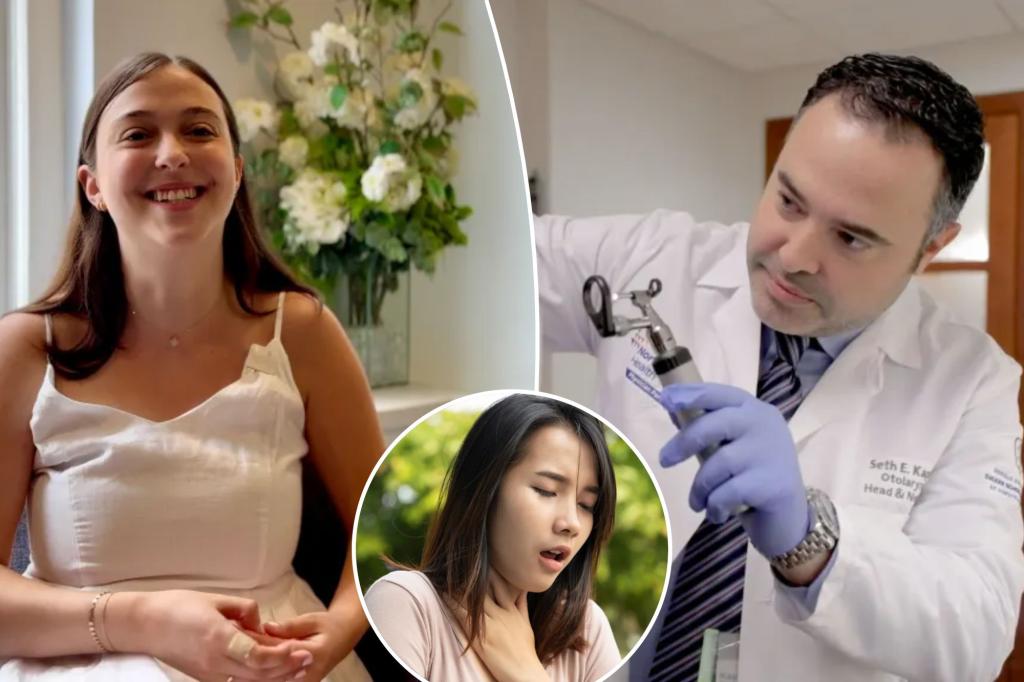It was un-frog-ettable.
Isabelle Zeidner, 23, first realized something was off with her body when she was 9 or 10 years old.
Her head colds were plagued by a lot of saliva — and gurgling noises that resembled toad croaks.
“I just remember that was, like, really weird,” the Manhattanite told The Post about her cold symptoms. “I started noticing that in fifth grade, and it lasted all the way through high school.”
Zeidner also observed the gurgling sounds when she consumed certain foods.
Eventually, she started hearing them all the time — especially when she kissed a guy.
She also experienced bloating, heartburn and bouts of vomiting if the gurgling persisted.
Those closest to her dismissed the issue as acid reflux, but Zeidner actually had retrograde cricopharyngeus dysfunction (R-CPD).
That term is a mouthful.
It’s just a complicated way of saying she couldn’t burp because a muscle at the top of her esophagus failed to relax properly, impairing the passage of air from the esophagus to the pharynx.
Zeidner underwent an endoscopy and a gastric emptying study in college to examine her digestive system.
Confusingly, the testing came back normal.
She was eventually referred to Dr. Seth Kaplan, a board-certified otolaryngologist, head and neck surgeon and director of Northwell Health’s Center for Voice and Swallowing Disorders.
In suspected R-CPD cases, Kaplan typically performs a head and neck exam that involves visualizing the throat and asks the patient four questions:
- Have you ever been able to belch?
- Do you have increased bloating?
- Do you have increased flatulence?
- Do you have pressure in your upper chest and throat and or gurgling noises?
“I answered those questions, and he’s like, ‘Yep, you definitely have this,’ ” Zeidner recalled.
The Columbia University social work grad student found quick relief in April with just one Botox injection into her cricopharyngeus muscle to relax it so air could escape.
Belch-issimo!
“The cricopharyngeus muscle acts as a valve, relaxing to allow food to pass into the esophagus and air to escape during belching,” Kaplan explained.
“It also prevents food from re-entering the pharynx,” he added. “In normal swallowing, it relaxes briefly then contracts to prevent reflux.”
Kaplan told The Post that diagnoses of R-CPD, also known as “no burp syndrome,” are rising as awareness increases.
Zeidner posted a TikTok about it in January, drawing 19.9 million views. Many of the comments were along the lines of “I FEEL SO SEEEEEEN.”
Why it happens is not fully understood.
Zeidner said no one in her family has the unusual condition, which usually manifests in childhood, though her parents did report she was “really colicky” as a baby.
“There’s no definitive evidence of genetic or developmental factors predisposing individuals to R-CPD,” Kaplan said.
“Potential factors include neurological issues, gastroesophageal reflux disease (GERD) and abnormal muscle function, possibly due to heightened muscle tone, but this is all theoretical as we don’t understand the underlying pathophysiology.”
Hallmark symptoms include the inability to burp, gurgling or rumbling noises in the throat, abdominal bloating, chest pressure and sometimes pain.
R-CPD typically can’t resolve on its own.
Left untreated, it can lead to chronic discomfort, esophageal distension and even perforation of the esophagus in severe cases.
Cricopharyngeal myotomy to cut the muscle is a treatment option.
Kaplan said he hasn’t had to perform that procedure since he has a 90% success rate with one Botox injection and close to 100% after a second injection, if it’s needed.
Botox typically takes two to three days to kick in.
A common side effect is a mild sore throat for a day or two.
“Some side effects include excessive or uncontrollable burping for two to three weeks,” Kaplan said. “If the patient has underlying reflux, it could temporarily be made worse two to three weeks after the procedure as well.”
Recurrence is possible, so repeat Botox injections may be necessary.
Patients can typically start drinking carbonated beverages five to seven days after the procedure.
“Now, if I drink a seltzer or a soda,” Zeidner said, “it’s definitely made me feel a lot better, a lot less indigestion, bloating. It’s just definitely a lifesaver.”
Read the full article here


